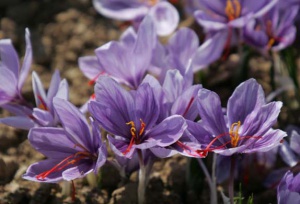Saffron
Origin & Description
Saffron is native to the Mediterranean and Western Asia. Other names for this herb are Autumn Crocus and Spanish Saffron. It is known to be the most expensive of the herbs. It can take 75,000 saffron blossoms to produce a single pound of the spice, and it is very labor-intensive. However, in light of its qualities, the expense for some seems to be well worth it. Those who can't afford to use Saffron usually substitute with Turmeric, which is considered the 'poor man's saffron'.
Actions
The herb Saffron is an Alterative (cleansing, helps remove waste products), Anti-Spasmotic (prevents or relieves spasms), Aphrodisiac (stimulates sexual desire), Carminative (relieves intestinal gas/distension), Diaphoretic (causes perspiration and elimination through the skin), Emmenagogue (promotes and regulated menstrual flow), Stimulant (increases internal heat, stimulates circulation).
Medicinal Uses
Saffron is known to counteract inflammatory conditions and stimulates blood circulation. It's beneficial for digestive problems, including intestinal gas. This herb also helps prevent kidney stones and is useful in the treatment of gout by lessening the build-up of uric acid in the tissues.
Function of organs such as the liver, gallbladder, spleen, kidneys and heart can improve with the use of saffron. Saffron is historically used for treating cancer, as it contains a carotenoid or antioxidant pigment that promotes cancer cell death. Some conditions that can be prevented or improved with the use of this herb are:
- Arthritis
- Cancer
- Colds
- Digestive Disorders
- Fevers
- Gas
- Gout
- Heartburn
- Hyperglycemia
- Hypoglycemia
- Jaundice
- Lactic Acid
- Liver Problems
- Menstruation (delayed)
- Perspiration
- Rheumatism
- Uric Acid
- Urinary Problems
- Water Retention
Side Effects
Saffron use is recommended for no longer than 6 weeks at a time. Side effects may include dry mouth, anxiety, dizziness, drowsiness, nausea or headache. Those suffering with Bi-Polar depression should use caution, as it may cause mood changes.
Pregnant women should not use this herb due to the possibility of uterine contractions. No information is available for those who are breast-feeding.
People who are allergic to Lolium, Olea/Olive and Salsola species may also be affected by the use of this herb. Large amounts of Saffron may be poisonous, 12-20 grams may even cause death. Symptoms of overdose are yellow skin or eyes or bleeding of the nose, lips or eyelids.
